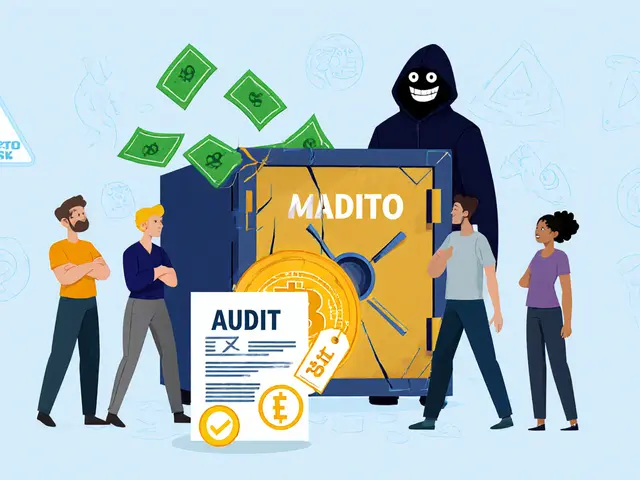SUNI Airdrop Campaign 2025: How to Claim, Token Details & Risks
Learn how to claim the SUNI token airdrop, understand allocation details, compare it to other 2025 drops, and see the risks and security tips you need.
Read More

Calculate your tax liability on cryptocurrency gains based on India's current regulations. The government taxes crypto gains at 30% flat rate plus 1% TDS (Tax Deducted at Source) on every transaction.
Cryptocurrency adoption in India is the fastest‑growing crypto ecosystem on the planet, topping every category of the 2025 Chainalysis Global Crypto Adoption Index. Even with some of the toughest tax rules, India’s retail users, businesses, and institutions are pouring money into Bitcoin, stablecoins, DeFi protocols and more. This article breaks down why the market is booming, how digital infrastructure fuels the surge, and what the regulatory tug‑of‑war means for the future.
Chainalysis ranks India first in overall adoption, retail, CeFi, DeFi and institutional scores. The country moved from a modest $1.4 trillion on‑chain volume in July‑2024 to $2.36 trillion by June‑2025 - a 69 % year‑over‑year jump that dwarfs North America’s 49 % growth. The surge isn’t a flash‑in‑the‑pan; it reflects a deep‑seated appetite for digital money across all socioeconomic layers.
Young developers in engineering colleges are building blockchain apps for hackathons. Small shop owners in tier‑2 cities accept Bitcoin and USDT for everyday sales. Large banks are trialing crypto‑backed liquidity pools. When you stack these layers together, the picture looks like a nation that lives and breathes crypto.
India’s fintech ecosystem is already world‑class. The Unified Payments Interface (Unified Payments Interface (UPI)) processes billions of transactions a day, proving that millions can shift money with a few taps. Services like eRupi expand that habit to government‑offered digital wallets. When a country is comfortable with instant mobile payments, adding a crypto layer becomes almost seamless.
Internet penetration sits above 70 % and smartphone usage is sky‑high. This connectivity means even remote villages can download a crypto wallet, verify a KYC, and start trading without stepping into a bank. The tech talent pool, boosted by a strong software services sector, supplies the developers who keep crypto exchanges, DeFi dashboards, and blockchain explorers humming.
Retail investors are the engine of India’s crypto boom. According to Chainalysis, Bitcoin alone attracted $4.6 trillion of fiat on‑ramps between July‑2024 and June‑2025 - more than double any other asset globally. Young professionals treat crypto like a second savings account, while farmers in Punjab experiment with stablecoins to hedge against crop‑price volatility.
The Bharat Web3 Association runs community workshops that demystify wallet security and smart‑contract basics. Their outreach programs reach over 200 k students every year, creating a pipeline of future blockchain entrepreneurs.
Stablecoins such as USDT and USDC dominate day‑to‑day transactions because they lock value to the dollar, making them useful for cross‑border remittances. New entrants like Circle’s EURC and PayPal’s PYUSD are gaining traction, signalling that Indian users are open to a diversified stablecoin portfolio.

Institutional adoption in India has accelerated on two fronts. First, traditional finance firms are launching crypto desks to offer clients exposure to digital assets. Second, home‑grown fintech unicorns are building DeFi infrastructure for lending, staking and yield‑farming.
Regulators have started carving out clearer guidelines, allowing banks to experiment with blockchain‑based trade finance without fear of immediate penalisation. Meanwhile, venture capital funds are raising dedicated crypto‑focused funds, injecting fresh capital into local blockchain startups.
All of this points to a market where crypto isn’t a niche hobby but a mainstream financial tool that institutions are learning to embed in their product suites.
India’s tax regime treats crypto gains as “income from other sources,” imposing a 30 % flat tax plus a 1 % TDS on every transaction. On paper, that looks discouraging. Yet the adoption numbers keep climbing, proving that users are willing to pay the price for access to a global asset class.
Rumours of a sovereign Bitcoin reserve have surfaced in recent policy drafts. If the government creates a state‑backed Bitcoin fund, it would be a watershed moment - turning the tax‑heavy environment into a supportive one.
Overall, the regulatory landscape is a push‑pull between strict fiscal rules and a pragmatic acceptance that crypto is here to stay. This tension fuels innovation: firms devise tax‑efficient structures, educators stress compliance, and policymakers see the economic upside of a thriving digital asset market.

| Metric | India | United States | Pakistan |
|---|---|---|---|
| Overall Index Rank | 1 | 2 | 4 |
| Retail Adoption Score | 1 (top) | 3 | 2 |
| DeFi Volume (US$ B) | 0.94 | 0.71 | 0.38 |
| CeFi Volume (US$ B) | 1.42 | 1.10 | 0.52 |
| Institutional Score | 1 (top) | 2 | 3 |
| On‑chain Transaction Growth YoY | 69 % | 49 % | 58 % |
The table makes it clear: India doesn’t just lead - it leads across the board. While the United States shines in spot‑Bitcoin ETFs, India’s balanced strength in retail, DeFi and institutional spheres makes it the most comprehensive market.
Whether you’re a student curious about blockchain, a small business owner looking to accept crypto, or a fund manager weighing exposure, the Indian ecosystem offers tools, talent and momentum to act now.
Yes. Crypto assets are not banned, but gains are taxed at 30 % and a 1 % transaction tax applies. The government is drafting clearer rules, and a possible Bitcoin reserve signals growing acceptance.
India’s massive fintech base, UPI dominance, high smartphone penetration, and grassroots enthusiasm create a unique blend that fuels retail, DeFi and institutional activity simultaneously.
Bitcoin leads in on‑ramps, followed by USDT and USDC stablecoins. Newer stablecoins like EURC and PYUSD are gaining modest market share.
Sign up with a UPI‑linked crypto wallet, integrate a QR‑code payment gateway, and train staff on basic security practices. Many providers offer turnkey solutions for under ₹10,000.
Official documents suggest the idea is under review. If approved, it would mark the first sovereign Bitcoin holding in South Asia and could soften the tax regime.
India's crypto scene is wild. UPI made it easy. People just get it now. No drama. Just transacting.
so india leads... again. funny how the country with the most confusing tax code somehow also has the most active crypto users. like, you charge 30% tax and 1% tds and people still buy btc like its candy. i mean... respect? or is this just chaos with good wifi?
i live in the us and honestly i'm jealous. everyone i know here is still scared of crypto or thinks it's a scam. but in india, even my cousin who runs a chai stall is accepting usdt. how did they make it so normal? i want that energy.
they say india leads but no one talks about the real story. the 30% tax is a trap. every rupee you earn from crypto gets drained. this isn't adoption, it's forced resilience. they're not embracing crypto, they're surviving it. and the 'sovereign bitcoin reserve' rumor? total distraction. the state wants control, not decentralization. watch them ban p2p next.
yo if you're in india and reading this - YOU'RE DOING IT RIGHT. stop waiting for permission. start building. use upi, learn wallets, join bharat web3. this isn't a trend, it's the future. and if you're outside india? stop comparing and start learning. the next billion users aren't in silicon valley, they're in small towns with smartphones and big dreams. go help them. don't just watch.
The data presented suggests a robust and multifaceted adoption curve, particularly in retail and institutional segments. However, the absence of longitudinal peer-reviewed validation raises questions regarding the granularity of transaction attribution. Are on-chain volumes being accurately disaggregated between speculative trading and utility-based use cases such as remittances or microtransactions? Without such clarity, the term 'leadership' may be statistically inflated.

Learn how to claim the SUNI token airdrop, understand allocation details, compare it to other 2025 drops, and see the risks and security tips you need.
Read More
Explore how governments, scholars, and the crypto community reacted to El Salvador's Bitcoin legal tender law, the adoption data, and its impact on future digital currency policies.
Read More
Professional crypto security audits in 2025 cost between $1,000 and $300,000+, depending on project complexity. Learn what drives audit prices, why cheap audits are risky, and how to budget properly to avoid catastrophic losses.
Read More
Comments (6)